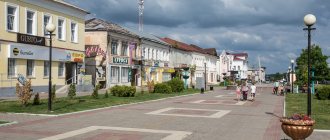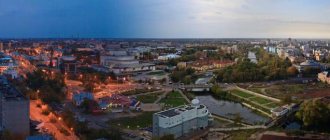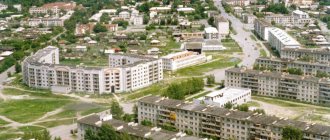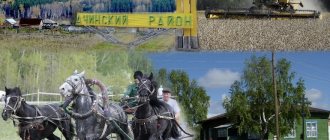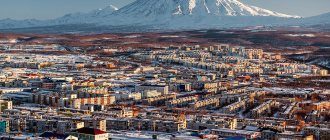The city of Ivanovo is the administrative, industrial and cultural center of the Ivanovo region, located in the picturesque places of the Volga basin of the Central Federal District, at a distance of 319 km from the capital, on the route of the Golden Ring of Russia. The territory of the city of Ivanovo is divided into 4 districts and is 104.5 square meters. km. The population at the beginning of 2012 was 408.8 thousand people. The first reliable documentary mention of the founder of our city - the village of Ivanovo - dates back to 1609. Although there are versions of an earlier existence of a settlement in the city. Based on the results of archaeological finds, the date of the city’s origin can be considered as the XIV-XV centuries.
According to the patrimonial inventory for 1630, Ivanovo was a large trading village, with 123 farms. Most of the peasants were engaged in various kinds of crafts and trade. Ivanovo residents traded canvas, dyed goods and prints at the surrounding bazaars and fairs.
In the middle of the 18th century, enterprising people emerged from among the Ivanovo peasants and opened linen manufactories in the village. Since the end of the century, printing on canvas has developed, and then calico printing.
Production developed most rapidly in the first third of the 19th century. Having accumulated capital, many redeemed serfs began to develop uninhabited territories around the village of Ivanova, transferring their production there. This is how settlements arose, which in 1853 formed Voznesensky Posad. By the middle of the 19th century, 130 enterprises of various sizes operated in Ivanovo and the settlements, producing fabrics worth 8 million rubles.
On July 21 (August 2 - according to the new style), 1871, the village of Ivanovo and Voznesensky Posad were united into the city of Ivanovo-Voznesensk, which became part of the Shuisky district of the Vladimir province. By the end of the 19th century, the city already had 59 factories and factories with 27 thousand workers. Most industrial establishments belonged to the finishing industry (weaving and spinning industries were less developed in the city) and produced finished cotton fabrics. Therefore, Ivanovo-Voznesensk was increasingly called the “calico kingdom” or “Russian Manchester”.
Soon after the revolution, on June 20, 1918, Ivanovo-Voznesensk became the administrative center of the new Ivanovo-Voznesensk province. In 1918, polytechnic and pedagogical institutes were opened in Ivanovo-Voznesensk. The Melange Plant became the largest construction site of industrialization; mechanical engineering (Ivtorfmash), chemical and food industries developed. The powerful potential of the Ivanovo-Voznesensk province was used for the economic development of the city.
In 1929, according to the new administrative zoning, the previously existing provinces were enlarged and transformed into regions. The Vladimir, Ivanovo-Voznesensk, Yaroslavl and Kostroma provinces merged into one Ivanovo Industrial Region (IPO) with a territory of 135 thousand square kilometers - more than two times larger than Belgium and Holland combined. In 1929-1936. the city of Ivanovo (December 27, 1932 Ivanovo-Voznesensk was renamed the city of Ivanovo) became the center of the IPO. In terms of the value of manufactured products, IPO ranked third in the country after the Moscow and Leningrad regions. 49% of the all-Union production of cotton fabrics and 77% of linen fabrics were concentrated here. After Moscow and Leningrad, Ivanovo-Voznesensk was considered the “third proletarian capital” of the USSR.
This is where the scale of many social and cultural projects that arose in Ivanovo at the turn of the 20s and 30s originated: a radical redevelopment of the city center, the construction of a grandiose House of Soviets, a huge drama theater, etc. Some of these ideas came to life, others remained in plans. Urban transformations were interrupted by the Great Patriotic War. A number of military units that fought on the fronts of the Great Patriotic War were formed in Ivanovo. During the war years, thousands of Ivanovo residents were awarded orders and medals.
The city set up hospitals, received evacuees, and rebuilt all types of industry on a war footing.
In the post-war years, the city's textile industry developed dynamically. New production facilities were put into operation, old ones were being reconstructed, and a new range of products was being developed. In 1958, construction of a worsted fabric factory began. Bolshaya Ivanovo Manufactory has mastered the production of staple fabrics from artificial fibers. In the 60s, massive construction of five-story buildings began in Ivanovo, and the first trolleybuses began to appear. In the 70s, gasification of the city was completed. By its centenary, Ivanovo occupied an area of 97 sq. km with a population of 425.9 thousand people.
Currently, the manufacturing industries of the regional center are based on 3 main types of economic activity:
- textile and clothing production, industry share is 36%;
- food production, industry share is 25.7%
- production of vehicles and equipment, the industry share is 21.8%.
Data by year
In 1871, when Ivanovo-Voznesenk received city status, 20,000 people lived in it. It grew quite quickly and in 1897 the number of residents was already 54,200, in 1914 - 146,000, and in 1917 - 174,400. The Civil War led to a sharp reduction in the number of city residents. In 1923 it was only 71,800 people. Pre-revolutionary indicators were achieved and surpassed only in the late 20s and early 30s. In 1931, statistics showed that 177,200 people lived in Ivanovo.
The policy of industrialization gave a new powerful impetus to the growth of the Ivanovo population. In 1939, its population was 285,182 people. Subsequently, this figure grew steadily. In 1956 it was 319,000, 1979 - 464,526, 1991 - 48,200.
The structural crisis of the 90s, associated with the destruction of the economy and social sphere of our country, led to a sharp deterioration in demographics in the city of Ivanovo. In dynamics, information about the number of its inhabitants looks like this:
- 1992 - 480,000 people.
- 1998 — 464000.
- 2001 — 452100.
- 2009 — 404539.
Then there was some stabilization. In 2011, the number of residents in the regional center was 409,300. But this did not lead to a radical improvement in the situation and further demographic decline continued. According to current information, the number of residents as of 2016 was 408,025, and in 2022 it is already 404,598. According to this parameter, the Ivanovo urban district ranks 49th in the Russian Federation.
Popular message topics
- Heroes of Space
We need to start the story about heroes of space with the people who made the flights themselves possible. The central figure on this list is rocket scientist K.E. Tsiolkovsky, - Ursa Minor constellation
The clear night sky is beautiful with its star diversity. Since ancient times, people, admiring the sky, assigned different names to certain groups of stars, looking for similarities in their outlines with objects or animals. - Chemical composition of a cell
Absolutely all living organisms on the planet consist of cells that are similar in chemical composition. A cell consists of a large number of chemical elements. Percentage of chemical elements
About the city
At the beginning of its history, Ivanovo was a settlement. This is how unfortified rural settlements are designated in archeology. The first written mention of the village dates back to 1608. During the Time of Troubles, it was captured by Polish invaders and was severely devastated. But it was restored quite quickly. Due to low soil fertility, farming was not a profitable activity here, and soon crafts, including textiles, became the main occupation of local residents.
At the end of the 17th century, the village was a famous center of Russian weaving. In the middle of the 18th century, the first manufactories appeared here. This is what science calls industrial enterprises with manual labor, but in which there is already specialization between workers. They were founded by capitalist peasants (entrepreneurs who came from the peasant class).
In 1853, Voznesensky Posad appeared nearby. In 1871 it merged with the village of Ivanovo, as a result of which the city of Ivanovo-Voznesensk arose, which immediately became one of the main centers of the textile industry of the Russian Empire. In 1932 the city received its modern name.
During Soviet times, the city remained the largest center of domestic and global textile production. At the same time, a number of large mechanical engineering plants were built. By the way, it was largely thanks to textile production that Ivanovo received its nickname “the city of brides.” After all, weaving work was traditionally female work and many young girls worked in Ivanovo factories.
Attractions
In one day you are unlikely to be able to thoroughly explore all the surroundings, since there are many places for entertainment and cultural heritage. But if you plan your route wisely, you will be able to visit the most popular tourist spots, having a great rest and expanding your horizons.
Churches and cathedrals
Compared to other cities, there are much fewer monasteries here. Start your tour at the Cathedral of the Assumption of the Blessed Virgin Mary . The shrine appeared about 180 years ago. It was built in 1834. The construction was carried out according to the design of the architect E.Ya. Petrova. These were mainly funds from local manufacturers. The style of construction is late classicism.
The Kazan Church is located on the banks of the Uvodi. In its place there was once a calico-printing factory. It was led by Christian Liman. Mikhail Ivanovich Yamanovsky, as the head of the Old Believers community, having received ownership of the building, decided to build a church. The object, as conceived by the architect Maricelli, was distinguished by its laconic beauty and grandeur.
The Transfiguration Cathedral was founded in 1889. The construction process dragged on for four years. The budget of the manufacturer M.N. Garelin was used. The building is characterized by rich decoration. On the facades you can see kokoshniks and turrets. The octagon is equipped with five chapters, and the windows have elegant platbands. A tented bell tower is installed in the west. There are three entrances with porches.
The Temple of Elijah the Prophet has a close relationship with the history of the city. Once upon a time there was Ilyinskaya Sloboda near the village. The merchant Alexander Lepetov, well-known at that time, donated funds for the construction of the shrine. The building is designed in the style of Russian classicism. Porticoes with four columns are installed on the north and south. The bell tower is visible from the west.
The Church of the Icon of the Mother of God “Joy of All Who Sorrow” was built in 1821. At that time, the Shuya merchant Kornoukhov bought the territory from Count Vorontsov. Dmitrievskaya Sloboda appeared in this place. It bordered on Voznesenskaya, the sides were separated by a river.
The Church of the Vladimir Icon of the Mother of God is one of the main decorations of the city. The Ascension Convent, established here earlier, was considered the value of the Korin and Shcherbakov family. On the outskirts of the property there was the Alekseevskaya women's almshouse. On April 21, 1902, the first stone was laid for the Church of the Vladimir Icon. In 1904 the main altar was illuminated.
The Holy Vedensky Convent is a building in the neo-Byzantine style, considered the hallmark and pearl of the city. It delights with the unusual design. The monastery appeared in the 1990s. The number of nuns is 150 women. It also bears another name “Red Temple” because of the red brick as the main material. Pilgrims come here and excursions are held here.
Museums, monuments, architecture
Perhaps one of the most remarkable objects is the mysterious house-ship , made in the style of constructivism. The house amazes with its unusualness. It was built according to the design of D. Friedman. The architectural features combine two styles - symbolism and romanticism.
It's hard to pass by the horseshoe house . Hundreds of tourists stop here to take a couple of original photographs. The perspective from above is especially unusual. This was once a residential building. Employees of the state political department lived here. It was built in the 1930s. A distinctive feature is the original shape of a semicircle, which resembles a horseshoe. The customer wanted the building to be miniature and compact. As a result, today there is a spectacular building with six floors on the street, which is difficult to pass by without attention. The first floor is used for a store.
The Collective House is another object that is definitely worth a look. An interesting monument of constructivism consists of several buildings. This is a federal level landmark. Development of the project began back in 1920. We tried to implement the project of a communal house. The building is located on Fairgrounds. The buildings are connected to each other by retail space and other buildings. Initially, there was an idea for a corridor system. But then they decided to divide the space into sections. Each building is landscaped. All parts have a different number of floors. There is a cozy courtyard.
The art museum was only in plans for a long time. Military and revolutionary incidents delayed the start of construction. In the 1960s The long-awaited foundation of the exhibition center took place. The authorities found funds for the implementation of the project from the fund. The museum is located on Lenin Avenue 33.
There is a monument to the fighters of the revolution in the city. It is located in the square and was once considered the central attraction. The obelisk was installed in the 1970s. The design causes controversial views among residents. The monument consists of two elements. The central area has a triangular shape, symbolizing the prison casemates.
The Ivanovo Calico Museum is definitely worth a visit, because the entire history of the textile industry is closely intertwined with this place. Calico manufacturing is an important area of the industry. The exhibition was founded in the 1980s. The exhibitions feature antique and modern items. The guide will reveal the secret of the craftsmen’s work. The first exhibits were donated by D. Burylin. Gradually the exhibition began to expand and gained popularity.
The museum is organized in the native mansion of the famous collector. The building itself attracts the eye with its unusual architecture. The façade is elegant and has stained glass windows. This is how many rich houses of the 19th and 20th centuries were decorated. Walking through the halls, you will see Ivanovo calicoes, interesting ornaments, and get closer to the applied arts.
There is even an entire exhibition dedicated to Vyacheslav Zaitsev. The popular fashion designer was born in Ivanovo. By the way, if you use the pedestrian crossing, you will find yourself at another exhibition of industry and art. It is literally a few steps away.
The Museum of the First Fireworks will tell about the first council of workers' deputies in Russia. Once upon a time there was a town council in this building. It was built around 1904. Before this period, there was another ancient wooden building here. It was later changed to brick. In 1980, an exhibition was placed here. The object is located on Sovetskaya Street.
The embankment is a wonderful place for residents and tourists to relax. Walking along the picturesque lines of the Uvod River, you can enjoy the endless beauty. The walking part of the city is always lively, especially on warm days. In the pre-revolutionary period, the territory was given over to factories and factories. Soon the enterprises were moved to the outskirts. The coastal area has been improved. They planted trees, organized flower beds, benches, gazebos, and laid paths. This created a cozy relaxation area. There is a cinema "Lodz" nearby.
Park of Culture and Leisure named after. V. Ya. Stepanova is a popular recreation point for the population and all visitors. In the past, the land was owned by famous manufacturers - the Garelins. It was part of their domain. The park was laid out in a beautiful forest area, where there are many pines, spruces, and birches. Local residents still call it Garelinsky. Here you can relax in a shady area. There are various attractions for children, and there are pavilions with ice cream and cotton candy. On holidays, folk festivals and fairs take place.
Country holidays, camp sites
Outside the city there are many wonderful complexes where you can have a great time - go fishing, swim in a pond, ride a boat, organize a picnic, etc. The picturesque location of the spring area "Beavers", the park-hotel "Villa Fortecia", "Volzhskoye Compound", "Glazova Gora" are in high demand.
Vacationers love to come to the Ivanovo equestrian farmstead, to the remote recreation center "Mera", to the tourist complex "Peaceful Marina", the eco-estate "Rozhstvo", "Semigorye", "Sosnovy Bor".
If you love fresh air and artistic landscapes, then go to the Country Home eco-complex and the Yakimikha recreation center. For those who like fishing, the fishing base "Cape Verde" and the fishing and tourist base "Ershikha" are suitable.
Tourists are of great interest in the Holy Lake. You can get to the place in just 2.5 hours. It is convenient to cover the distance by car. A bus runs here from the city. Increased attention to the reservoir appeared in the last century.
The natural reservoir appeared as a result of the melting of ancient glaciers. The area is loved by vacationers because it gives peace and quiet. The lake is surrounded by pine forest, so there is rarely wind here. The water in the reservoir is warm and unusually clean. You can even see the sandstone bottom. It warms up to the very bottom. The total depth is 3.8 meters.
Flora and fauna are rich. This beautiful natural area is recognized as a protected area. There are many other bodies of water on the territory of Ivanovo. The largest lake is Rubskoye; the Lamenskoye or Bogoyavlenskoye and Zaborye reservoirs are rich in fish.
Gender and age
The gender and age structure fully justifies the nickname “city of brides.” Characterized by a significant predominance of the female population over the male population. According to the same census, there were 228,758 representatives of the fair sex in the urban district in 2010, and 179,572 men.
This trend is fully consistent with the indicators characterizing the population of the Ivanovo region as a whole. According to data for 2022, the number of women in the region per 1000 men is 1217.
The age structure of the population of the urban district is as follows. As of 2010, there were 56,128 children aged 0 to 15 years. The number of people of working age was 266,873, and pensioners over the age of 60 were 85,329.
Coat of arms
The coat of arms of Ivanovo is presented in the form of a French shield bordered by a gold line.
A woman in a silver shirt and red sundress is depicted in an azure field. On her head is a scarf and a red kokoshnik. She sits facing the viewer's left. Behind the knees is a spinning wheel comb with a tow, held with the right hand. In front of the girl stands a spinning wheel, the wheel of which she rotates with her left hand. All items are made of gold. They symbolize the textile industry.
The artistic composition is included in the State Heraldic Register of the Russian Federation under No. 111. Adopted by decision of the Ivanovo City Duma No. 33-1 of May 22, 1996. The author is V. Almaev.
Migration
Migration flows in the city are very contradictory. On the one hand, as a result of internal migration there is an outflow of population. Moscow is in first place in terms of the number of people leaving, St. Petersburg is in second place.
The balance of external migration is positive. Mainly due to citizens of former Soviet Asian republics. But this fact cannot indicate the attractiveness of life in the region. The overwhelming majority of migrants do not seek to stay here permanently, but, after working for some time, go home.
At the moment, we can confidently state that negative demographic trends in Ivanovo have not yet been overcome. Only a radical improvement in the economic situation in the city can turn the situation around.
Climate
It is clear that for a person who decides to change his place of residence within Russia, the climate of Ivanovo will be of considerable importance. Many people move around the country in search of a more comfortable climate for themselves. The weather in Ivanovo meets the following parameters:
- the climate itself is temperate continental;
- this means that the winter here is quite mild, on average - 12;
- and cool summers up to +18 on average.
All other increases in air temperature, both in winter and summer, are considered abnormal changes and are not typical for the Ivanovo region. But there is one distinctive feature that is inherent in this region: the weather often changes due to changing cyclones, so it can suddenly be very hot in summer and warm in winter.
Monastery of Old Believers
The main water artery of Ivanovo is the navigable river Uvod. Thanks to her, the residents of the town were able to establish strong economic ties with neighboring regions. As mentioned above, the soil in these places did not allow the cultivation of bread, but it was an excellent environment for harvesting a large flax crop.
In 1638, after the Skopin-Shuisky family died out, the village passed to the Cherkasy princes. Another 30 years later, the population of Ivanovo was already 800 people, not counting the administration and clergy. New temples continued to appear. It was their number that was the main indicator of the growth and enrichment of any Russian village of that time. When a church schism occurred in the country related to the reforms of Patriarch Nikon, the town was overwhelmed by Old Believers. The then history of the city of Ivanovo was closely connected with the priest movement. These people fled to the outskirts of the country away from the central government, which was repressing heretics.

